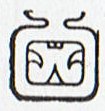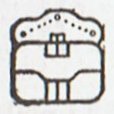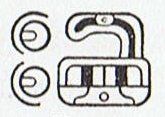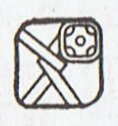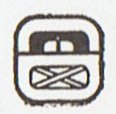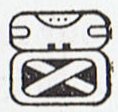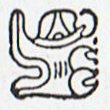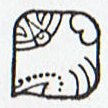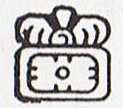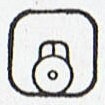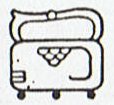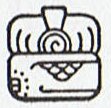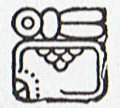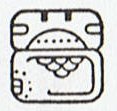|
TRANSLATIONS
"The seventh locality is the ceiba tree with the crocodile head for a base, the so-called imix ceiba, and the accompanying glyphs read ti-yax-te 'at the ceiba'." (Kelley)   This is the only locality where the head of the Rain God is turning backwards (to the right in Maya picture language). Also the crocodile head at bottom looks backwards. Though the feet of the Rain God are going forward. Or maybe the feet have lost contact with the ground? The Rain God is possibly climbing the tree. The Tree of Life in rongorongo is Niu, and its location is at the end of the year: ... Niu in Aa1-13 can be compared with niu in Pa6-20. Niu belongs to the end of the year, and it seems to come after winter solstice, judging from its position in P ... In rongorongo a glyph turned backwards mostly means a season is ended. 7 * 53 = 371. The three glyph parts 'at the ceiba' (ti-yax-te) should be documented here. First comes a sign which Kelley regards (I think) as purely a 'preposition' determining location, 'at'. As all pictures, though, it contains much more. Gates has a better grip I think (and better pictures too). Already at his first glyph type (Imix, the 1st day sign, the sea-dragon) he says that "The knot or tie
in form 1.1 is the same as seen in the red ties surrounding numbers like the 6-2.0 on Dr. p. 24 ..." The sun eye at left means that it is a season of the sun which is bound together. The open 'flare' at right should be the ends of the string, and sun of course is afraid of kaikai - threatening him with death. Sun can only be stopped by strings made from hair of women. The open 'flare' may be the same sign as in Tzek and Pax:
The strings could otherwise also be navel strings - birth strings, which follow the death strings. The open flare caused by strings tying up the count of the year - at (ti) the end of the year - could be the reason for the open top of the niu glyph type, at e.g. Pa6-20:
Furthermore, the 'ghost' sign in form of open limbs (cfr Pa6-15) may also be related to the 'open flare' sign in the Maya system of pictures. Next (in ti-yax-te) comes the word used both in the 7th month (Yaxkin) and in the 10th month (Yax):
7 * 20 = 140 and 10 * 20 = 200. Mostly yax is said to be a colour, 'green' (from which derives the secondary meaning of 'new'): "In Green we have a positive glyph and settled value. In the different languages the word (in Maya, Choltí, Chortí, Tzeltal yax; in Quiché, Kekchí, Pokonchí, rax; in Mam, Ixil, etc. chax) has the several meanings of green (including blue), new, fresh, and sudden. Note the Quiché raxcamic, sudden death, muerte repentina ... We may expect any of these meanings, according to context, and whether we are dealing with plant growth, change of seasons, astronomical or zodiacal passages, or other subjects." (Gates) Sudden greenery suits Yaxkin (with kin, the sun, as the cause). In the 10th month, Yax, the colour probably is meant, because the superfixes in the following Sac and Ceh are white respectively red. The yax sign in Yax is not the same as that in Yaxkin. There are 3 'fingers' on each side of the center in both Yax and Yaxkin, but the central forms are different - there are 2 rings in Yax (possibly indicating the 2nd half of the year) and the 'curl' is open at right instead of at left as in Yaxkin. The bottom part (cauac, 'the grapes') in Ch'en, Yax, Sac, and Ceh is the sign of storm, maybe visualizing rain clouds:
"The sign cauac, wherever it could be pinned down, appeared as a sort of general time-count base. Alone, or with the wing-affix ... and with numerals, it is a fixed variant for the Tun-sign. This Morley was the first to verify. It is also the common element in the four vinal signs for Ch'en, Yax, Sac, Ceh, differentiated only by their superfixes. Ch'en means Well; Yax and Sac means Green, White; and the superfixes are the characters fully established for those colors. The superfix for Ceh means Red, but the Maya and Quiché Ceh, Quieh, mean Deer." (Gates) Birth and death are events which colour the sky in red, as if in blood. Yet red normally is associated with birth, not with death. Death usually takes its colour from the White Moon Goddess. Deer is the reversal of red. 4 * 20 = 80 days arriving beyond midsummer (Mol) are characterized by change (storm, cauac). Ch'en, though, sounds like drought ('well'). 160 + 80 = 240 - Mol is the 8th month. The stormy season (cauac) is the 19th (end of sun) in the sky region. In the region of earth it could be the 6th season, Cimi (death):
Let us return to the Tree. The 14th month, Kankin (in Yucatec), is referred to as Uniu, Uneu, in other Mayan languages. Glyphs (and inscriptions) show this month to be a Tree month:  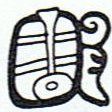 The rightmost sign is inscriptional and it makes me associate to the skull of One Hunaphu up in the tree. I think we must add niu to the list of Polynesian words possibly related to the Mayan vocabulary:
|
|||||||||||||||||||||||||||||||||||||||||||||||||||||||||||||||||||||||||||||||||||||||||||||||||||||||||||||||||||||||||||||||||||||||||||||||||||||
